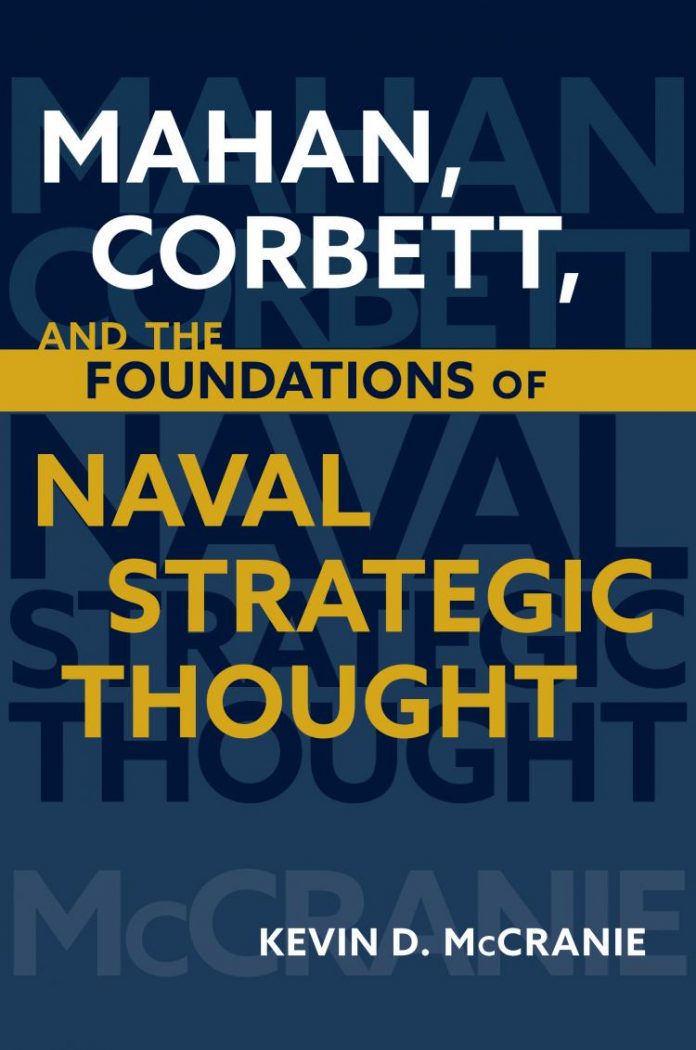
Mahan, Corbett, and the Foundations of Naval Strategic Thought. By Kevin D. McCrainie. Annapolis, MD: Naval Institute Press, Annapolis, Maryland 2021, ISBN 978 1 68247 574 4.
Reviewed by John Johnston
For more than a century, the writings of Alfred Thayer Mahan and, to a lesser extent, those of Sir Julian Corbett have dominated thinking on naval strategy. England’s rise to maritime pre-eminence between the late seventeenth and the early nineteenth centuries, Mahan and Corbett argued, had rested on the creation of a large navy that could control the sea lanes of communication, protect the homeland, and overwhelm enemy fleets in battle.
Yet, as the wars which the English had fought repeatedly showed, tactical superiority was more decisive than numerical superiority and control of the seas was the most effective lever for achieving national objectives whether in peace or war, a lesson which the wars of their own times reinforced. Naval strategy, they therefore argued, was a question of acquiring and using the sea power necessary for those purposes, not merely one of building fleets.
Whilst those ideas were attractive during the Cold War, they were forgotten after the Cold War had ended, the Soviet Union had imploded, and the US became the only internationally dominant power. Secondly, military activity shifted to prolonged campaigns on land, where the lessons of French colonial warfare were more useful than those of naval battles in the French Revolutionary Wars, and navies were increasingly reduced to coastguard functions for which concepts like sea control seemed to have little relevance. The study of naval strategy, one might argue, would have become a quaint curiosity, were it not for the Iranians acting like corsairs in the Persian Gulf and the Arabian Sea, the Russians using the sea to sustain their war effort in Syria, and the Chinese striving to dominate southern and western Pacific Ocean.
Kevin McCranie’s book is a welcome intrusion into the debate about responding strategically to these challenges. McCranie does not try to make Mahan and Corbett’s ideas fit contemporary problems and possible responses to them: he describes how Mahan and Corbett developed their ideas and how they evolved them through the first decades of the twentieth century. He then examines how Mahan and Corbett applied concepts of land warfare and civil-military relations which had been expounded by writers like Jomini and Clausewitz to the maritime environment and he considers how they used case studies from history to illustrate and to crystallise the conclusions which they had reached. Only then does McCranie explore the distinct ways in which each man thought of using the different elements of sea power, such as sea denial or expeditionary warfare, to greatest effect. Much of their thinking involves concepts whose complexity makes them difficult to comprehend, and McCranie explains those concepts through simple diagrams and figures. For this alone, McCranie’s book is invaluable for understanding Mahan’s and Corbett’s ideas and so focusing the reader’s thoughts on the underlying concept of each idea.
While Mahan and Corbett can be seen as antithetical figures, McCranie shows that they complement each other. In emphasising the brute strength of maritime force, Mahan put the navy into the framework of national security, while Corbett’s description of the interacting details of that framework explains the navy’s role in grand strategy. Both men adapted and altered their thoughts in the light of experience, and Mahan’s admonition to understand what is the same but never to forget to identify the differences remains critical for separating ‘grave, well-considered thought’ from ‘wild speculation’ in formulating maritime strategy. With this book, McCranie makes Mahan and Corbett the tools with which to start that task.



